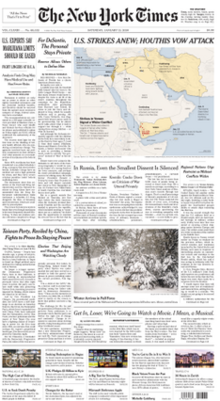Some Known Details About News Articles
Some Known Details About News Articles
Blog Article
Facts About News Articles Revealed
Table of ContentsNews Articles Things To Know Before You Get ThisMore About News ArticlesSee This Report about News ArticlesNews Articles Can Be Fun For AnyoneLittle Known Questions About News Articles.
Good expertise of various subjects gives pupils a competitive edge over their peers. Despite the fact that digital and social media sites are conveniently obtainable, we should not neglect just how vital it is to check out the newspapers. Moms and dads must try and instill the routine of reviewing a paper as an everyday routine to proceed the legacy of the revered print tool.Information stories additionally include at the very least one of the adhering to crucial features loved one to the desired audience: distance, prominence, timeliness, human rate of interest, strangeness, or repercussion.
Within these restrictions, information tales also aim to be detailed. Among the bigger and extra highly regarded newspapers, justness and balance is a major factor in presenting info.
Papers with a global audience, for instance, often tend to use a much more formal design of creating. The particular choices made by a news electrical outlet's editor or editorial board are often gathered in a design guide; typical design overviews consist of the and the US Information Design Book. The main goals of news writing can be summarized by the ABCs of journalism: precision, brevity, and clearness.
An Unbiased View of News Articles
Generally, journalists will certainly not make use of a lengthy word when a short one will do. They make use of subject-verb-object building and construction and vivid, energetic prose (see Grammar). They offer anecdotes, instances and metaphors, and they rarely depend on generalizations or abstract concepts. News authors attempt to stay clear of making use of the same word greater than when in a paragraph (occasionally called an "resemble" or "word mirror").
Headlines often omit the subject (e.g., "Jumps From Watercraft, Catches in Wheel") or verb (e.g., "Feline woman fortunate"). A subhead (also subhed, sub-headline, subheading, subtitle, deck or dek) can be either a subordinate title under the main headline, or the heading of a subsection of the article. It is a heading that comes before the main text, or a team of paragraphs of the major text.

Additional billboards of any of these types might appear later on in the short article (specifically on succeeding pages) to attract further reading. Such signboards are also made use of as guidelines to the article in see here various other sections of the magazine or site, or as ads for the piece in various other publication or websites. Typical structure with title, lead paragraph (recap in strong), various other paragraphs (details) and call details.

Example of a hard-lead paragraph NASA is recommending an additional room project. The spending plan demands roughly $10 billion for the project.
The NASA announcement came as the agency asked for $10 billion of appropriations for the job. An "off-lead" is the second most important front web page information of the day. The off-lead shows up either in the leading left corner, or straight below the lead on the. To "hide the lead" is to start the short article with background info or details of secondary significance to the viewers, requiring them to read even more deeply into an article than they should have to in order to find the necessary points.
Getting My News Articles To Work
Common usage is that a person or 2 sentences each create their own paragraph. Journalists normally define the company or framework of a newspaper article as an inverted pyramid. The essential and most intriguing aspects of a tale are put at the beginning, with sustaining info adhering to in order of diminishing significance.
It enables individuals to check out a subject to just the depth that their interest takes them, and without the imposition of details or nuances that they might think about pointless, however still making that info offered to a lot more interested readers. The upside down pyramid structure also allows articles to be cut to any kind of approximate size during design, to fit in the space available.
Some writers begin their tales with the "1-2-3 lead", yet there are numerous kinds of lead available. A twist can refer to multiple things: The last tale in the news program; a "pleased" tale to finish the program.
Longer posts, such as magazine cover short articles and the items that lead the within sections of a paper, are called. Function tales differ from straight information in several ways. Foremost is the lack of a straight-news lead, the majority of the time. Instead of supplying the essence of a story a knockout post up front, feature authors may try to entice viewers in.
News Articles - The Facts
A feature's very first paragraphs usually relate an intriguing moment or event, as in an "anecdotal lead". From the particulars of a person or episode, its view quickly broadens to generalizations about the story's subject.

The Editor's Toolbox: A Referral Guide for Beginners and Professionals this hyperlink (2001) Allan M. Siegal and William G. Connolly. The New York City Times Handbook of Design and Use: The Official Design Guide Utilized by the Writers and Editors of the World's Most Reliable Newspaper (2002) M. L. Stein, Susan Paterno, and R.
Report this page